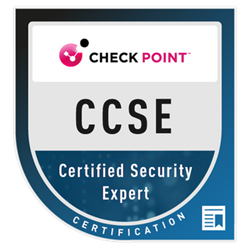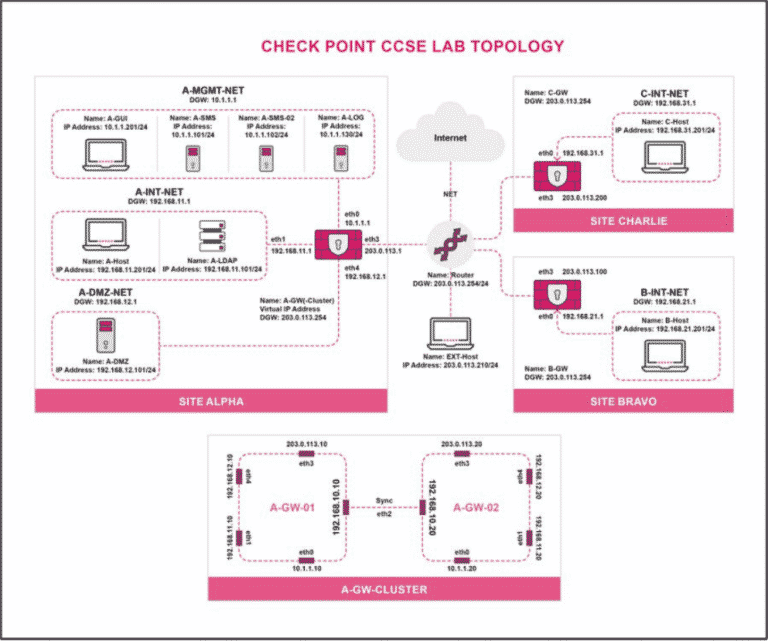Obiettivi | Certificazione | Contenuti | Tipologia | Prerequisiti | Durata e Frequenza | Docenti | Modalità di Iscrizione | Calendario

Il Corso Check Point CCSE Security Expert è un’esperienza formativa avanzata e completa, pensata per partecipanti che aspirano a perfezionare le loro competenze nel campo della sicurezza informatica. Durante il corso, i partecipanti affrontano una serie di lezioni teoriche e pratiche che esplorano un’ampia varietà di argomenti legati alla gestione, configurazione e risoluzione dei problemi delle soluzioni Check Point.
I partecipanti apprendono come progettare e implementare soluzioni di sicurezza aziendale di livello avanzato, utilizzando tecnologie e strumenti Check Point come firewall, VPN, intrusion prevention system (IPS), mobile access, data loss prevention (DLP) e gestione unificata delle minacce (UTM). Il corso si focalizza sull’acquisizione delle competenze necessarie per configurare e amministrare sistemi di sicurezza complessi e per identificare e risolvere le problematiche comuni che possono emergere durante il loro impiego.
Attraverso un mix di lezioni, dimostrazioni pratiche e laboratori, i partecipanti sviluppano una solida conoscenza delle best practice e delle tecniche per proteggere le reti aziendali da attacchi informatici. Il corso contribuisce alla preparazione dell’esame di Certificazione Check Point Security Expert (CCSE).
Contattaci ora per ricevere tutti i dettagli e per richiedere, senza alcun impegno, di parlare direttamente con uno dei nostri Docenti (Clicca qui)
oppure chiamaci subito al nostro Numero Verde (800-177596)
Obiettivi del corso
Di seguito una sintesi degli obiettivi principali del Corso Check Point CCSE Security Expert:
- Approfondimento delle tecniche avanzate di configurazione e gestione dei firewall Check Point.
- Implementazione e ottimizzazione di soluzioni VPN per la sicurezza delle reti aziendali.
- Utilizzo e personalizzazione dei sistemi di prevenzione delle intrusioni (IPS) per rafforzare la sicurezza.
- Gestione efficace dell’accesso mobile e delle politiche di prevenzione della perdita di dati (DLP).
- Applicazione delle strategie di Unified Threat Management (UTM) per una protezione integrata.
Certificazione del corso
Esame Check Point Certified Security Expert (CCSE); Questo esame è una valutazione approfondita per i candidati che desiderano dimostrare la loro competenza avanzata nelle soluzioni di sicurezza Check Point. Questo esame mette alla prova la capacità dei candidati di configurare e gestire firewall avanzati, VPN, e sistemi di prevenzione delle intrusioni (IPS). Inoltre, i partecipanti sono testati sulla loro abilità nell’implementare soluzioni di accesso mobile e strategie di prevenzione della perdita di dati (DLP), nonché nella gestione di Unified Threat Management (UTM). L’esame richiede anche una comprensione approfondita dell’ottimizzazione e della risoluzione dei problemi in ambienti di sicurezza complessi. Superare questo esame conferma che il candidato possiede le competenze necessarie per operare efficacemente come un esperto di sicurezza nell’ambito delle tecnologie Check Point.
Contenuti del corso
- Identify basic interfaces used to manage the Check Point environment.
- Identify the types of technologies that Check Point supports for automation.
- Explain the purpose of the Check Management High Availability (HA) deployment.
- Identify the workflow followed to deploy a Primary and Secondary servers.
- Explain the basic concepts of Clustering and ClusterXL, including protocols, synchronization, connection stickiness.
- Identify how to exclude services from synchronizing or delaying synchronization.
- Explain the policy installation flow.
- Explain the purpose of dynamic objects, updatable objects, and network feeds.
- Understand how to manage user access for internal and external users.
- Describe the Identity Awareness components and configurations.
- Describe different Check Point Threat Prevention solutions.
- Articulate how the Intrusion Prevention System is configured.
- Obtain knowledge about Check Point’s IoT Protect.
- Explain the purpose of Domain-based VPNs.
- Describe situations where externally managed certificate authentication is used.
- Describe how client security can be provided by Remote Access.
- Discuss the Mobile Access Software Blade.
- Explain how to determine if the configuration is compliant with the best practices.
- Define performance tuning solutions and basic configuration workflow.
- Identify supported upgrade and migration methods and procedures for Security Management Servers and dedicated Log and SmartEvent Servers.
- Identify supported upgrade methods and procedures for Security Gateways.
Attività Laboratoriali
- Navigate the Environment and Using the Management API
- Deploy Secondary Security Management Server
- Configure a Dedicated Log Server
- Deploy SmartEvent
- Configure a High Availability Security Gateway Cluster
- Work with ClusterXL
- Configure Dynamic and Updateable Objects
- Verify Accelerated Policy Installation and Monitoring Status
- Elevate Security with HTTPS Inspection
- Deploy Identity Awareness
- Customize Threat Prevention
- Configure a Site-to-Site VPN with an Interoperable Device
- Deploy Remote Access VPN
- Configure Mobile Access VPN
- Monitor Policy Compliance
- Report SmartEvent Statistics
- Tuning Security Gateway Performance
Tipologia
Corso di Formazione con Docente
Docenti
I docenti sono Istruttori Autorizzati Check Point e in altre tecnologie IT, con anni di esperienza pratica nel settore e nella Formazione.
Infrastruttura laboratoriale
Per tutte le tipologie di erogazione, il Corsista può accedere alle attrezzature e ai sistemi presenti nei Nostri laboratori o direttamente presso i data center del Vendor o dei suoi provider autorizzati in modalità remota h24. Ogni partecipante dispone di un accesso per implementare le varie configurazioni avendo così un riscontro pratico e immediato della teoria affrontata. Ecco di seguito alcuni scenari tratti dalle attività laboratoriali:

Dettagli del corso
Prerequisiti
Aver frequentato il Corso Check Point CCSA o possedere competenze equivalenti.
Durata del corso
- Durata Intensiva 3gg;
Frequenza
Varie tipologie di Frequenza Estensiva ed Intensiva.
Date del corso
- Corso Check Point CCSE (Formula Intensiva) – Su richiesta – 09:00 – 17:00
Modalità di iscrizione
Le iscrizioni sono a numero chiuso per garantire ai tutti i partecipanti un servizio eccellente.
L’iscrizione avviene richiedendo di essere contattati dal seguente Link, o contattando la sede al numero verde 800-177596 o inviando una richiesta all’email [email protected].


